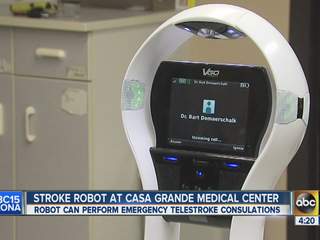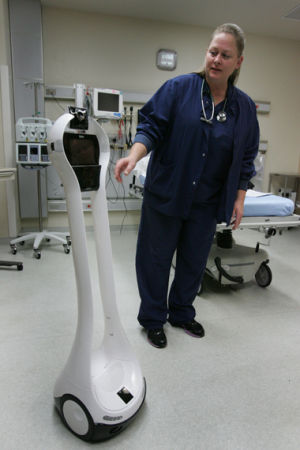Mayo Clinic uses VGo to Enhance Stroke Care in Remote Clinic
 Mayo Clinic's Neurology department is using VGo to diagnose and treat patients faster in a remote clinic an hour away. Since November, twelve patients have been successfully diagnosed and treated for stroke at Casa Grande Regional Medical Center (CGRMC) through the new teleneurology program using VGo.
Mayo Clinic's Neurology department is using VGo to diagnose and treat patients faster in a remote clinic an hour away. Since November, twelve patients have been successfully diagnosed and treated for stroke at Casa Grande Regional Medical Center (CGRMC) through the new teleneurology program using VGo.
“Telemedicine was deployed in order to bring the expert to the patient, when they needed it most, where they needed it most as opposed to transferring the patient from the rural community to the large urban neurological center,” says Doctor Demaerschalk, a Medical Director at the Mayo Clinic in an interview with ABC News. Click here to watch the video from ABC News.
Through the robot, a Mayo Clinic neurologist can examine a patient and perform an assessment. The VGo's screen shows the face of the consulting Mayo Clinic doctor, and the doctor is able to control move around, control the robot's camera and even take snapshots by using their laptop or Mac all from Phoenix.
This means that patients no longer need to travel an hour away to the Phoenix area for treatment. Using VGo, rural clinics are able to have access to a neurologist any time of the day or night.
“Before this, stroke patients had to go to the Valley to be treated for stroke. Now we can keep them here in the hospital and treat them here in the community. Their families don’t need to travel to the Valley,” Karen Schussler, registered nurse and director of the CGRMC Emergency Department.
Recently, Weymouth Fogelberg, 95, was taken to CGRMC and assessed for a stroke by a doctor in Phoenix via the VGo.
“I felt like the doctor was right there in the room with me,” Fogelberg told theThe Maricopa Monitor. Click here to read the entire article from The Maricopa Monitor.
“It’s amazing at what a remarkable instrument that is. The hospital can only have so many neurologists and you don’t have a stroke at everyone’s convenience,” said Fogelberg.
Using VGo not only means that patients and their families have to travel less, it also means that critical care can be provided at a moment's notice.
CGRMC CEO Rona Curphy said the technology will save lives. “In the case of a stroke, time is a critical component and telestroke medicine buys us time for our patients.”
“Urgent and immediate virtual care can be provided to patients — collaborations between stroke neurologists and physicians at the remote sites has resulted in 96 percent accuracy in diagnosing stroke.” Dr. Demaerschalk said.
 Dr. Demaerschalk emphasizes that the technology is not designed to replace face-to-face contact between doctor and patient.
Dr. Demaerschalk emphasizes that the technology is not designed to replace face-to-face contact between doctor and patient.
“But our research strongly suggests that the technology can enhance valuation and treatment for our patients in rural areas, as well as peer-to-peer collaboration among physicians,” he said.
Casa Grande Regional Medical Center is one of 11 hospitals to partner with the Telestroke program through Mayo Clinic.
